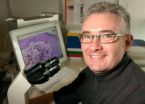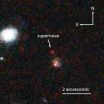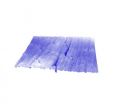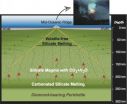(Press-News.org) Astronomers have discovered hundreds of previously-unknown sites of massive star formation in the Milky Way, including the most distant such objects yet found in our home Galaxy. Ongoing studies of these objects promise to give crucial clues about the structure and history of the Milky Way.
The scientists found regions where massive young stars or clusters of such stars are forming. These regions, which astronomers call HII (H-two) regions, serve as markers of the Galaxy's structure, including its spiral arms and central bar.
"We're vastly improving the census of our Galaxy, and that's a key to understanding both its current nature and its past history, including the history of possible mergers with other galaxies," said Thomas Bania, of Boston University. Bania and his colleagues presented their work to the American Astronomical Society's meeting in Long Beach, California.
The astronomers are using the National Science Foundation's (NSF) Green Bank Telescope (GBT) in West Virginia and Arecibo Telescope in Puerto Rico, and data from NASA's Spitzer and WISE (Widefield Infrared Survey Explorer) satellites. They plan to expand the effort to include Australian radio telescopes.
The effort began with a survey of the Milky Way using the GBT. The scientists looked for HII regions by seeking faint emission of hydrogen atoms at radio wavelengths that are unobscured by the dust in the Galaxy's disk. By detecting these emissions, dubbed radio recombination lines, or RRLs, the GBT survey more than doubled the number of known HII regions in the Milky Way. They continued that work using the Arecibo Telescope, finding additional objects, including the largest HII region yet found, nearly 300 light-years across.
Data from previous surveys with radio and infrared telescopes, including Spitzer and WISE, helped to guide the new search. Later work analyzed similar emissions of helium and carbon atoms.
"The great sensitivity of the GBT and the Arecibo telescope, along with advanced electronics, made our new surveys possible," said Dana Balser, of the National Radio Astronomy Observatory (NRAO).
"Data from WISE shows about 2,000 new HII-region candidates that we are studying with the GBT to confirm," said Loren Anderson, of West Virginia University.
The work so far has helped refine astronomers' understanding of the Galaxy's structure. They found concentrations of star formation in a poorly-understood spiral arm and at the end of the Galaxy's central bar.
"HII regions are the best tracers of the Milky Way's spiral structure, and this work is an excellent way to improve the map of our Galaxy," Bania said.
Another major focus of the surveys is to study chemical variations in different regions of the Galaxy. Variations in the abundance of elements heavier than hydrogen can trace the history of star formation, and also indicate regions possibly containing material incorporated into the Galaxy through mergers with other galaxies throughout its history.
"We've already been surprised to learn that the thin, tenuous gas between the stars is not as well-mixed as we thought," Balser said. "Finding areas that are chemically different from their surroundings can point to where gas clouds or smaller galaxies may have fallen into the Milky Way," he added.
"Just as geologists traverse the landscape, mapping different rock types to reconstruct the Earth's history, we're working to improve the map of our Galaxy to advance our understanding of its structure and its history," Bania said. "The radio telescopes are our tools for making these new and better maps."
###
The National Radio Astronomy Observatory is a facility of the National Science Foundation, operated under cooperative agreement by Associated Universities, Inc.
Mapping the Milky Way: Radio telescopes give clues to structure, history
Discovery of hundreds of previously-unknown sites of massive star formation improves map of our home Galaxy, will advance understanding of its structure and history
2013-01-10
ELSE PRESS RELEASES FROM THIS DATE:
Mount Sinai researchers foresee new therapies and diagnostics for deadly fibrotic diseases
2013-01-10
A team of scientists has developed a playbook for ending the devastating impact of fibrotic diseases of the liver, lung, kidney, and other organs, which are responsible for as many as 45 percent of all deaths in the industrialized world. Despite the prevalence of these illnesses, which are caused by buildup of scar tissue, there are no approved antifibrotic drugs on the market in the U.S. A top fibrosis expert from the Icahn School of Medicine at Mount Sinai and three other institutions have described drug targets and compounds they hope will prove broadly effective in ...
Drug-resistant melanoma tumors shrink when therapy is interrupted
2013-01-10
Researchers in California and Switzerland have discovered that melanomas that develop resistance to the anti-cancer drug vemurafenib (marketed as Zelboraf), also develop addiction to the drug, an observation that may have important implications for the lives of patients with late-stage disease.
The team, based at the University of California, San Francisco (UCSF), the Novartis Institutes for Biomedical Research (NIBR) in Emeryville, Calif., and University Hospital Zurich, found that one mechanism by which melanoma cells become resistant to vemurafenib also renders them ...
The farthest supernova yet for measuring cosmic history
2013-01-10
What if you had a "Wayback Television Set" and could watch an entire month of ancient prehistory unfold before your eyes in real time? David Rubin of the U.S. Department of Energy's Lawrence Berkeley National Laboratory (Berkeley Lab) presented just such a scenario to the American Astronomical Society (AAS) meeting in Long Beach, CA, when he announced the discovery of a striking astronomical object: a Type Ia supernova with a redshift of 1.71 that dates back 10 billion years in time. Labeled SN SCP-0401, the supernova is exceptional for its detailed spectrum and precision ...
Spin and bias in published studies of breast cancer trials
2013-01-10
Spin and bias exist in a high proportion of published studies of the outcomes and adverse side-effects of phase III clinical trials of breast cancer treatments, according to new research published in the cancer journal Annals of Oncology [1] today (Thursday).
In the first study to investigate how accurately outcomes and side-effects are reported in breast cancer trials, researchers at the Princess Margaret Cancer Centre and University of Toronto (Toronto, Canada) found that in a third of all trials that failed to show a statistically significant benefit for the treatment ...
Particles of crystalline quartz wear away teeth
2013-01-10
This press release is available in German.
Dental microwear, the pattern of tiny marks on worn tooth surfaces, is an important basis for understanding the diets of fossil mammals, including those of our own lineage. Now nanoscale research by an international multidisciplinary group that included members of the Max Planck Institute for Evolutionary Anthropology in Leipzig has unraveled some of its causes. It turns out that quartz dust is the major culprit in wearing away tooth enamel. Silica phytoliths, particles produced by plants, just rub enamel, and thus have ...
First image of insulin 'docking' could lead to better diabetes treatments
2013-01-10
A landmark discovery about how insulin docks on cells could help in the development of improved types of insulin for treating both type 1 and type 2 diabetes.
For the first time, researchers have captured the intricate way in which insulin uses the insulin receptor to bind to the surface of cells. This binding is necessary for the cells to take up sugar from the blood as energy.
The research team was led by the Walter and Eliza Hall Institute and used the Australian Synchrotron in Melbourne, Australia. The study was published today in the journal Nature.
For more ...
Magma in mantle has deep impact
2013-01-10
HOUSTON – (Jan. 9, 2013) – Magma forms far deeper than geologists previously thought, according to new research at Rice University.
A group led by geologist Rajdeep Dasgupta put very small samples of peridotite under very large pressures in a Rice laboratory to determine that rock can and does liquify, at least in small amounts, as deep as 250 kilometers in the mantle beneath the ocean floor. He said this explains several puzzles that have bothered scientists.
Dasgupta is lead author of the paper to be published this week in Nature.
The mantle is the planet's middle ...
After decades of research, scientists unlock how insulin interacts with cells
2013-01-10
The discovery of insulin nearly a century ago changed diabetes from a death sentence to a chronic disease.
Today a team that includes researchers from Case Western Reserve University School of Medicine announced a discovery that could lead to dramatic improvements in the lives of people managing diabetes.
After decades of speculation about exactly how insulin interacts with cells, the international group of scientists finally found a definitive answer: in an article published today in the journal Nature, the group describes how insulin binds to the cell to allow the ...
GW researchers find variation in foot strike patterns in predominantly barefoot runners
2013-01-10
WASHINGTON –A recently published paper by two George Washington University researchers shows that the running foot strike patterns vary among habitually barefoot people in Kenya due to speed and other factors such as running habits and the hardness of the ground. These results are counter to the belief that barefoot people prefer one specific style of running.
Kevin Hatala, a Ph.D. student in the Hominid Paleobiology doctoral program at George Washington, is the lead author of the paper that appears in the recent edition of the journal Public Library of Science, or PLOS ...
A history lesson from genes
2013-01-10
When Charles Darwin first sketched how species evolved by natural selection, he drew what looked like a tree. The diagram started at a central point with a common ancestor, then the lines spread apart as organisms evolved and separated into distinct species.
In the 175 years since, scientists have come to agree that Darwin's original drawing is a bit simplistic, given that multiple species mix and interbreed in ways he didn't consider possible (though you can't fault the guy for not getting the most important scientific theory of all time exactly right the first time). ...
LAST 30 PRESS RELEASES:
Sleeping in on weekends may help boost teens’ mental health
Study: Teens use cellphones for an hour a day at school
After more than two years of war, Palestinian children are hungry, denied education and “like the living dead”
The untold story of life with Prader-Willi syndrome - according to the siblings who live it
How the parasite that ‘gave up sex’ found more hosts – and why its victory won’t last
When is it time to jump? The boiling frog problem of AI use in physics education
Twitter data reveals partisan divide in understanding why pollen season's getting worse
AI is quick but risky for updating old software
Revolutionizing biosecurity: new multi-omics framework to transform invasive species management
From ancient herb to modern medicine: new review unveils the multi-targeted healing potential of Borago officinalis
Building a global scientific community: Biological Diversity Journal announces dual recruitment of Editorial Board and Youth Editorial Board members
Microbes that break down antibiotics help protect ecosystems under drug pollution
Smart biochar that remembers pollutants offers a new way to clean water and recycle biomass
Rice genes matter more than domestication in shaping plant microbiomes
Ticking time bomb: Some farmers report as many as 70 tick encounters over a 6-month period
Turning garden and crop waste into plastics
Scientists discover ‘platypus galaxies’ in the early universe
Seeing thyroid cancer in a new light: when AI meets label-free imaging in the operating room
Neutrophil-to-lymphocyte ratio may aid risk stratification in depressive disorder
2026 Seismological Society of America Annual Meeting
AI-powered ECG analysis offers promising path for early detection of chronic obstructive pulmonary disease, says Mount Sinai researchers
GIMM uncovers flaws in lab-grown heart cells and paves the way for improved treatments
Cracking the evolutionary code of sleep
Medications could help the aging brain cope with surgery, memory impairment
Back pain linked to worse sleep years later in men over 65, according to study
CDC urges ‘shared decision-making’ on some childhood vaccines; many unclear about what that means
New research finds that an ‘equal treatment’ approach to economic opportunity advertising can backfire
Researchers create shape-shifting, self-navigating microparticles
Science army mobilizes to map US soil microbiome
Researchers develop new tools to turn grain crops into biosensors
[Press-News.org] Mapping the Milky Way: Radio telescopes give clues to structure, historyDiscovery of hundreds of previously-unknown sites of massive star formation improves map of our home Galaxy, will advance understanding of its structure and history




